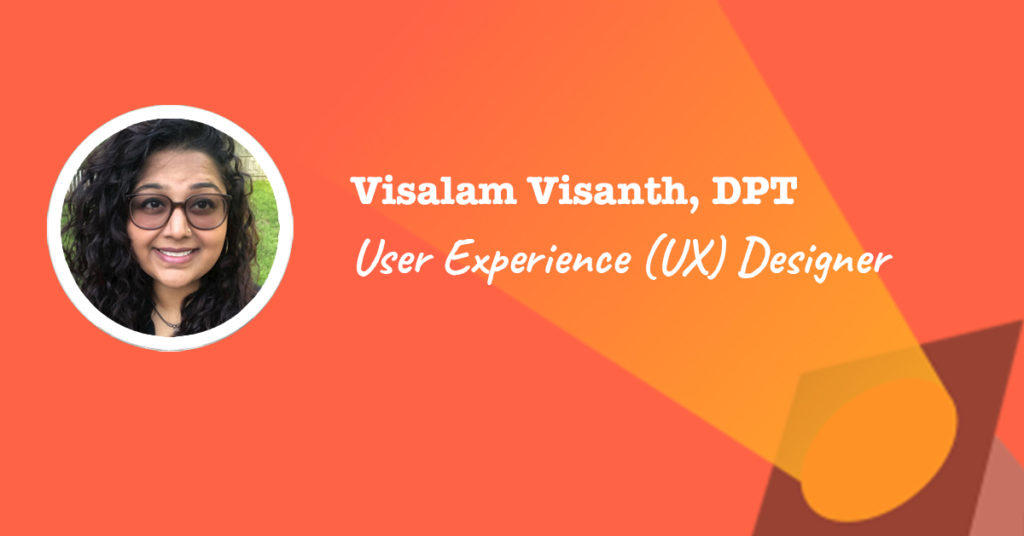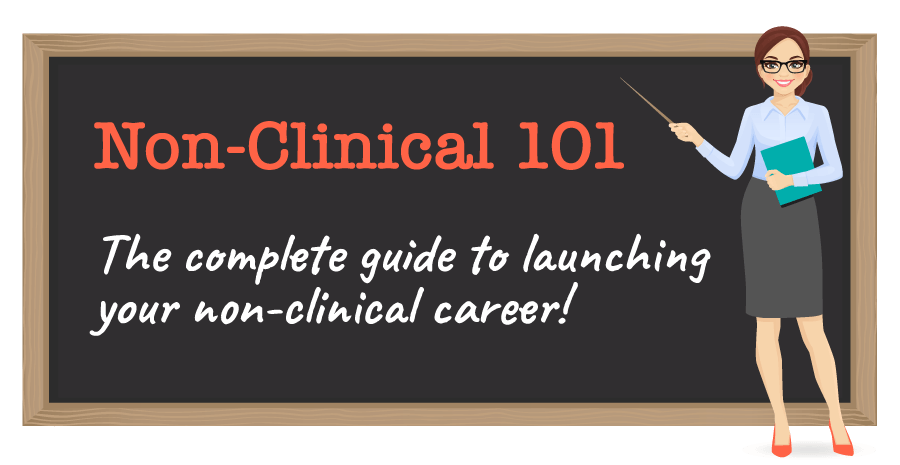This week’s spotlight features Visalam Vasanth, who burned out on patient care quickly—but she took initiative to invest in herself and found a career path that she is truly passionate about!
This post may contain affiliate links or codes. This won’t increase your cost, but it helps keep TNCPT alive, and free of annoying ads! Thank you for your support. 🙂
What is your full name and title at your current job?
Visalam (Vis) Vasanth, DPT
UX (User Experience) Associate Designer at the University of Texas Health (UT Health) San Antonio
UX Design Tutor at Careerfoundry
Where did you go to PT school, and what year did you graduate?
I got my DPT (Doctor of Physical Therapy) from Rutgers University-Newark (Formerly University of Medicine & Dentistry of New Jersey) in 2011.
What did you do when you first finished school, and for how long?
I worked as a doctor of physical therapy on the east and west coasts for about four years (Beverly Hills, Los Angeles, and at multiple locations in northern NJ).
I started in skilled nursing and found my way into pediatrics (early intervention, school-based, and outpatient).
What did you enjoy about your early roles? What didn’t you enjoy?
I loved the patient care portion, but didn’t enjoy the amount of time I spent each day on documentation using poorly designed EMRs and EHRs.
As a healthcare provider, I felt that the EMRs and EHRs were not designed with PTs in mind.
On top of our already busy schedules, we were forced to spend more time learning to use non-intuitive and poorly designed software. This is what sparked my passion for technology and my desire to improve healthcare technology.
When did you realize you wanted to go non-clinical, and why?
I felt myself burning out at about the four year mark of being a PT. I would work 10-hour days treating patients (skipping lunch on most days) and end up with a mountain of documentation I needed to complete on top of that.
After living in five cities over six years, I created a relocation/moving blog to share my packing tips and tricks. That is when I discovered my passion for web development and UX design.
Adjusting the look and feel of my blog gave me immense satisfaction. When I reached the limits of what the built-in editor was capable of, I taught myself programming in CSS, so I could get the look and feel just the way I wanted.
I got so fascinated by the world of technology that I left my career as an established physical therapist to pursue my newfound passion for technology.
My goal was to leverage my PT experience, along with my interest in technology, to improve healthcare documentation systems and influence health tech at a larger scale.
This was not an easy decision to make, but I knew that if I never tried, I would regret it later.
What are you doing these days?
I work as a UX Associate Designer at the University of Texas Health (UT Health) San Antonio. I also share my passion for UX design by tutoring UX design to fellow career changers at Careerfoundry. I also contract as a UX designer and mentor newbies in the field.
Before my current role, I worked as a UX designer at 2 startups, one of which focused on creating an intuitive EMR system for PT, ST, and OT. And before that, I worked at Oracle Corporation as a Cloud Solution Engineer with a UI/UX focus.
Are you still treating patients, or are you solely non-clinical?
Solely non-clinical.
How long have you been a user experience designer?
I’ve been in this role for about a year, and I have been in the tech space for about four years total.
How did you find your UX design job? Did you apply or find it through a connection?
I found it through LinkedIn and applied for the position.
Did you do anything special to your resume and cover letter to land the user experience design job?
I did have 1 year of technical work experience as a Cloud Solution Engineer/Developer on my resume, so that helped. For PTs wanting to switch into health tech, I recommend a shorter path than the one I took.
I didn’t know what I could do within technology with my skill set at the time so it took me a little longer to realize that UX was where I wanted to be.
My path: PT → full-stack web development certification at University of Texas Austin → freelance developer → worked at Oracle as a cloud solution engineer → UX design certification/bootcamp → UX design startups → UX design position at a larger organization
Recommended path: UX design certification → internship/volunteer at startups (while studying so you gain work experience) → pursue additional certifications/credentials → freelance → UX design positions
While having a development background definitely helps to understand technical principles, skills like empathy and knowledge of the scientific process carry over into the role of a UX designer.
Something significant to add to your resume is transferable skills. UX design and PT/OT/ST surprisingly have a lot of similarities and overlap.
Editor’s note: Curious about other paths into healthcare tech? Check out this spotlight we did on Tanavi Raicar, who is now Senior Application Development Analyst at CVS Health!
How do you think working as a PT prepared you for user experience design?
The PT process (initial evaluation, assessment, plan of care, treatment, discharge) is analogous to the user experience process (experience strategy, user research, information architecture, interaction design).
UX design has a research component where you interview users to discover their pain points, needs, and motivations. This approach is very similar to the initial eval, where you uncover your patients’ complaints and medical history and make your observations. Then, based on the information gathered, you make an assessment, which in UX would be a problem statement and persona.
And like in physical therapy, where it is an iterative process where treatment plans are re-evaluated and modified, the same goes for the UX process. The solution to a patient’s problem is the personalized treatment plan, whereas the solution for a user’s problem is the customized interface design.
What was the interview like for the role?
Interviews in the tech space are very different from interviews in healthcare. My experience in interviewing for a PT position has been one interview session with a few Q&As and a tour of the facility. A typical user experience design interview process has more than one interview:
- An interview with human resources (HR) to learn more about you (in other words, a phone screen)
- A technical Interview (1-2 hrs) where you are presented with a whiteboard challenge and encouraged to talk through your UX process OR a take-home challenge
- An interview with the hiring manager and team
Every company is a little different. Some have more steps and some have fewer steps in their interview processes.
Did you get any special certifications or training along the way to get into user experience design?
I earned a Full Stack Web Development Certification (Coding Bootcamp) from the University of Texas Austin and then a UX Design certification from CareerFoundry. If I had known that there were UX certifications out there, I would have directly done the UX certification instead of the developer certification first.
For those folks without a technology background interested in switching to UX design, I recommend finding a good UX certification program. UX design has a lot of psychology, research, and design.
Coming from a medical background puts you at an advantage to learning UX because it matches the way we were trained to observe, evaluate, treat.
Did you read any books, take any courses, or do anything special overall to get you where you are today?
I recommend the following books to get started:
- The Design of Everyday Things by Don Norman
- Don’t Make Me Think by Steve Krug
- How to Speak Tech by Vinay Trivedi
How have people reacted to you leaving patient care?
I’ve had mixed reactions. Some of my fellow healthcare professionals have told me what I am doing is awesome, while others have just given me a puzzled “you’re out of your mind” look.
What’s a typical day or week in the life like for you? What types of tasks and responsibilities fill your time?
I start my day looking at my messages and email. After that, I pretty much choose a project with the closest deadline and I focus on my UX process and going through it.
If I am in the User Research phase, I will:
- Schedule user interviews
- Create an interview script
- Create and conduct surveys
- Create personas
- Create user stories
- Perform task analysis
- Create user flows
These deliverables allow me to really understand the end-users of the application I’m designing for.
If I’m in the Information Architecture portion, I work on how the content on the site will be laid out to create the optimal user experience.
If I’m in the Design portion, I get to use my creative side to design solutions, and test my designs with users and iterate on them.
Depending on the company or setting you work in, you may have to work in the office or be allowed remote days every week.
Roughly speaking, how are the hours and pay as a UX designer compared to PT?
When it comes to pay, you will initially take a pay cut when you are starting, but once you get the experience, the earning potential can be a lot higher than PT depending on how high up the ladder you want to go.
In my experience, it took me a few years to make the same amount as I would have as a PT.
What type of person do you think would do well in your role?
Since UX design is an iterative process, you will need to have somewhat of a thick skin when it comes to dealing with your design ideas. Sometimes your ideas will be marveled at, and other times you will need to handle constructive criticism.
In addition, having good presentation skills, being detail-oriented, and having a passion for improving technology is important. You will also need interpersonal skills and empathy since you collaborate with many teams, including UX, marketing, project management, development, and end-users.
If you are drawn more to the research side than design, you can look into the user experience researcher (UX researcher) roles as well.
Editor’s note: Check out this spotlight on Kate Paolini, M.S., CCC-SLP, who is now a UX researcher for Meta!
Do you work remotely or on-site?
I currently work on-site, but I have had UX design jobs where I worked 100% remotely as well. It is a very flexible profession in general, but your own role will depend on the company you work for.
Occasionally, this type of role can require travel to the client/user site if you are on the UX research side.
Thanks for your insight, Vis!
User experience (UX) is one of 25 (!!) non-clinical career tracks included in the lifetime access membership to Non-Clinical 101!





